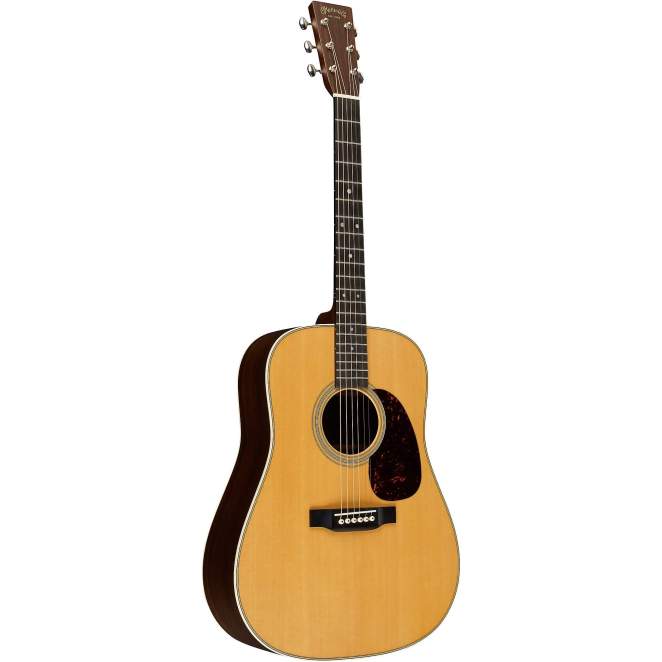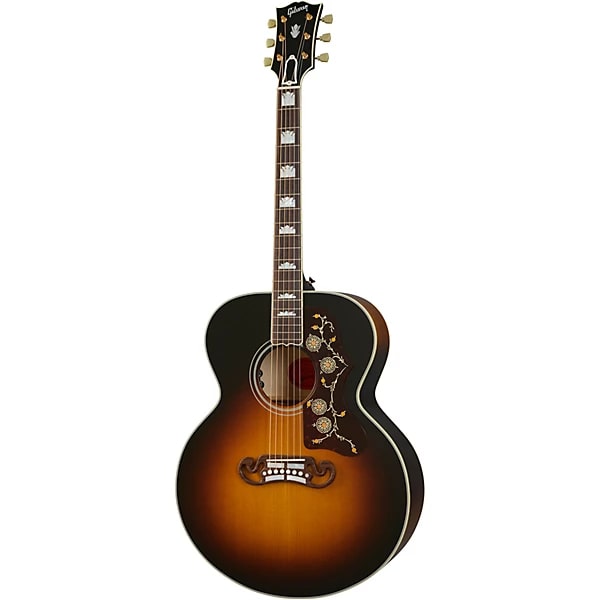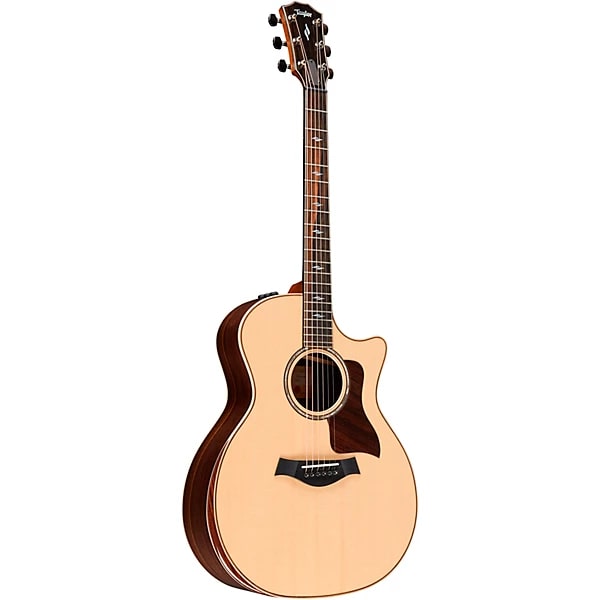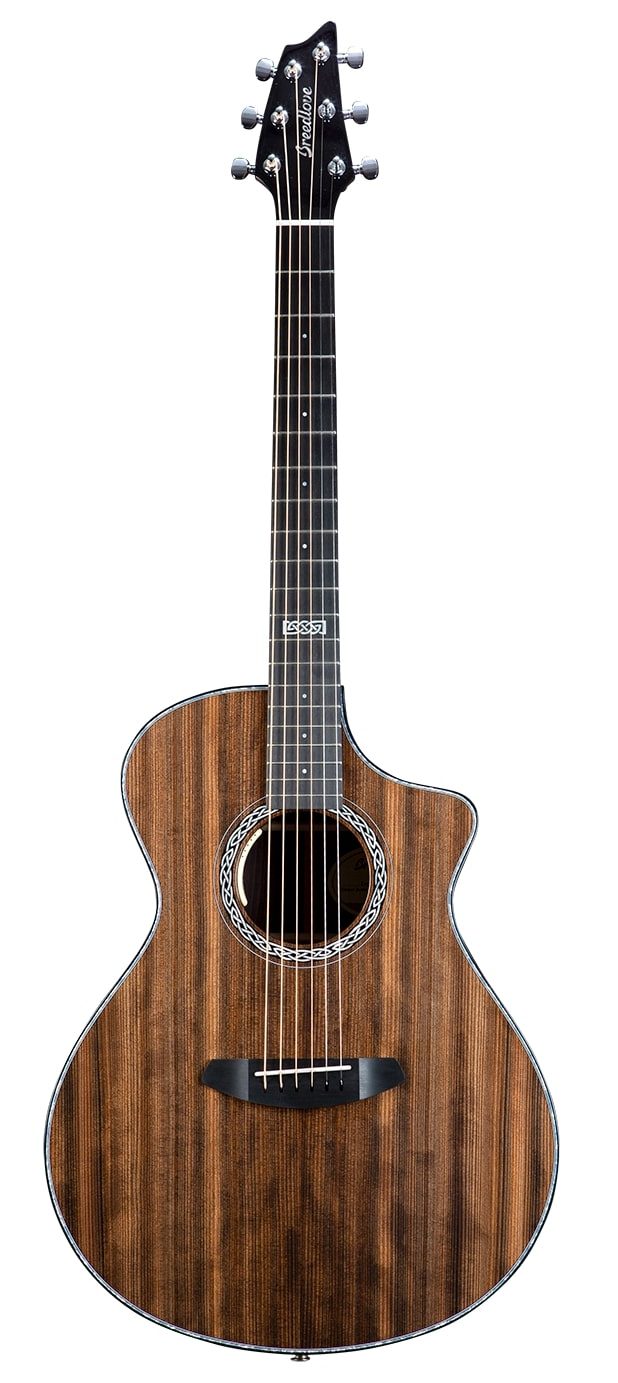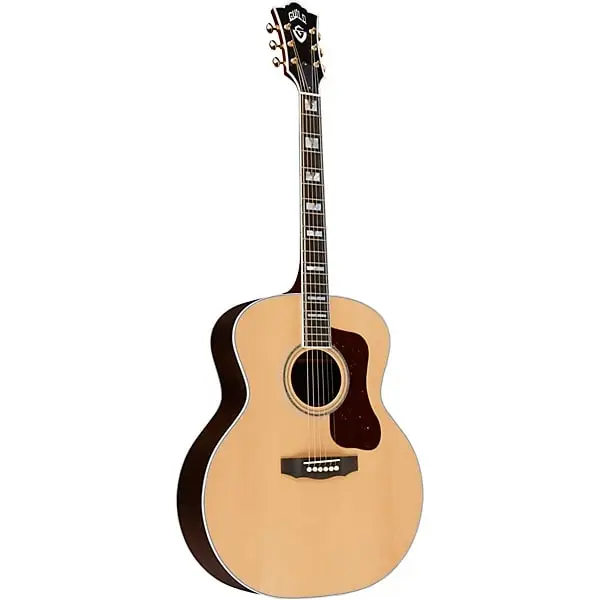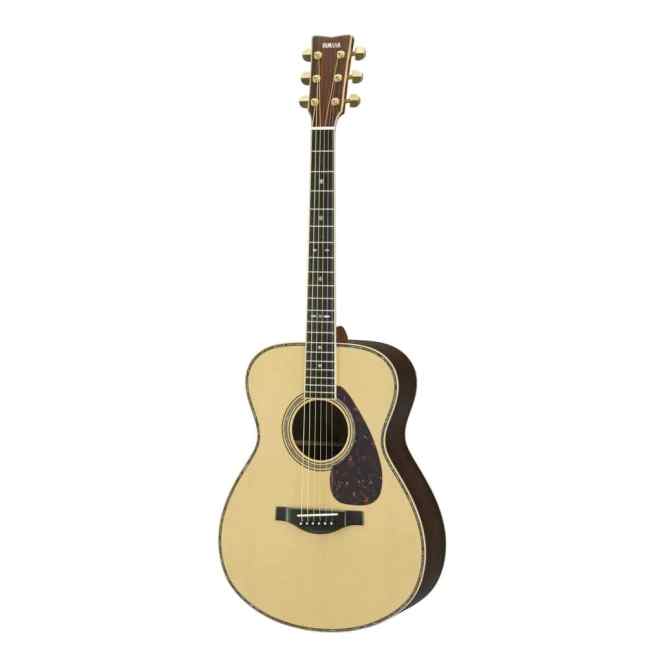When you buy through our links, we may earn an affiliate commission.
There's no better way to be sure you find your forever instrument than to invest in a high-end acoustic guitar.
If you're a singer/songwriter or guitarist like me, your acoustic guitar is like your right hand. It's always by your side when inspiration strikes, almost like an extension of your own body and soul. Therefore, it has to fit your style, your preferences, and your needs like a glove.
But finding that perfect fit isn't easy. There are tons of different factors to take into consideration, and there's nothing worse than being stuck with a low-quality instrument and a bad case of buyer's remorse. Cheap guitars can have low quality control standards that result in poor playability, visible flaws, lackluster sound, and more.
Fortunately, a high-end acoustic guitar is always going to be fine-tuned for exceptional sound, outfitted with premium hardware, and meticulously designed to offer stunning looks, allowing you to not only play your best but look and feel your best as well.
So which is the best high-end acoustic guitar for you? In this article, I'll take a close look at the crème de la crème—the absolute best high-end acoustic guitars––and offer up my expert opinions regarding their build, sound quality, value, best use cases, and more.
My Top Pick is the Martin D-28 for its iconic tone, exquisite craftsmanship, and next-level comfort and durability. This gold-standard acoustic guitar has been the choice of country, bluegrass, and rock legends since its inception, and continues to serve as the flagship model for the Martin Guitar company today.
But that's not all––I've picked out something for everyone, whether it's a booming jumbo you're after or a cutaway model. I've also included a handy buyer's guide to point you in the right direction if you're having trouble choosing the best acoustic guitar for your needs.
Whether you're a professional musician or simply someone with an appreciation for the finest in craftsmanship, our list is full to the brim with great picks for players of all experience levels.
Now, let's find your forever guitar!
Quick Summary of the Best High-End Acoustic Guitars
- Martin D-28 (Best Overall)
- Gibson Acoustic SJ-200 Original (Premium Choice)
- Takamine P4DC (Budget Pick)
- Taylor Guitars 814ce V-Class (Best Grand Auditorium)
- Breedlove Legacy Concert CE (Best Concert)
- Guild F-55 (Best Jumbo)
- Larrivée L-03R (Unique Body Shape)
- Yamaha LS36 ARE (Best Value)
Best High-End Acoustic Guitars
Best Overall
SPECS
- Body Shape: Dreadnought
- Tonewoods: Solid Sitka Spruce top, East Indian Rosewood back and sides, Select Hardwood neck, Ebony fretboard
- Bracing: Forward-Shifted X-Brace
The Martin D-28 has been the quintessential workhorse of music legends like Hank Williams, The Beatles, Johnny Cash, Neil Young, Bob Dylan, and many, many more. To this day, Martin Guitars' D-28 continues to be celebrated as much for its rich history as for its iconic sound.
The D-28 is crafted with premium tonewoods, featuring a solid Sitka spruce top—known for its strong projection and dynamic range—paired with solid East Indian rosewood back and sides, which contributes to its warm, bold sound and rich harmonics.
The classic dreadnought body shape is renowned for its powerful, full-bodied sound, deep bass response, and stunning versatility. Its large, square-shouldered design provides a robust, balanced tone that shines in a wide variety of genres, perfect for singer/songwriters who need all the range.
This deep resonance is further enhanced by its forward-shifted X-bracing, contributing also to the guitar's rich, well-balanced sound and increased responsiveness. Other guitars on our list, like the Larrivée L-03R, come close to the D-28's projection and versatility, but nothing beats the original.
I personally love the D-28's updated modern low-oval neck profile––it provides a smooth, ergonomic feel for both intricate fingerstyle playing and robust strumming.
If you can get your hands on one, you'll instantly see (and hear, and feel) why the Martin D-28 is counted among the best high-end acoustic guitars of all time. It narrowly beats out the Gibson SJ-200 on this list due to its iconic dreadnought body style that's perfect for just about any player.
Check out our full review of the Martin D-28.
What Could Be Better
- Prohibitively priced for some
Premium Choice
Designed to pack a punch both sonically and visually, the SJ-200 is bursting with premium appointments and intricate craftsmanship––truly the best of the best.
SPECS
- Body Shape: Super Jumbo
- Tonewoods: Solid Sitka Spruce top, Flamed Maple back and sides, 2-piece Maple neck, Rosewood fingerboard
- Bracing: Traditional hand scalloped X-bracing
Picking up the Gibson SJ-200, I could literally feel the quality. Holding and playing this guitar feels like taking a brand-new luxury car for a joyride––comfortable, but a little bit... scary? And ultimately VERY satisfying.
Known as the "King of the Flat-Tops," the Gibson SJ-200 is another contender for the world's most famous acoustic guitar. Since its release in 1937, its wide use by American artists has made the Super Jumbo one of the most widely played acoustic guitars of our time.
And today's iteration is an absolute stunner. Crafted with a solid Sitka spruce top and high-quality maple back and sides, the SJ-200 Original offers a balanced tonal palette with a crisp, articulate high-end and warm, resonant lows, resulting in its well-rounded and dynamic sound.
The SJ-200 Original features a distinctive super jumbo body design that generates a bold, commanding presence and delivers a rich, deep tone with robust bass response and exceptional volume. It's definitely a handful, but there's nothing better for keeping up with a full band onstage.
This acoustic-electric guitar comes equipped with the LR Baggs VTC Under Saddle Pickup system, delivering a natural, studio-quality sound when amplified, while preserving the guitar's rich, acoustic character and dynamic nuances.
This gorgeous instrument features some iconic design elements, like its ornate pickguard, striking mustache bridge, and intricate mother-of-pearl crown inlays, reflecting Gibson's commitment to both visual elegance and superior craftsmanship.
If you're torn between our top picks, the SJ-200 might be a better choice than the D-28 for gigging musicians who need onboard electronics and a bit more oomph for cutting through a full-band mix.
Check out our full review of the Gibson SJ-200.
What Could Be Better
- It's such a work of art, you might hesitate to take it out of its case
Budget Pick
The Takamine P4DC offers a wonderful blend of traditional luthier skills with contemporary refinements, making for one of the best high-end acoustic guitars on the market at a reasonable price.
SPECS
- Body Shape: Dreadnought
- Tonewoods: Solid Spruce top, Solid Sapele back, Laminated Sapele sides, Mahogany neck, Rosewood fingerboard
- Bracing: X Scalloped Bracing
Now for a slightly more modern, not to mention more affordable pick. The Takamine P4DC combines premium tonewoods, careful construction, and slick modern tech to create a professional-quality acoustic-electric guitar that's perfect for the studio or stage.
After a few strums, my first thought was, "This guitar sounds amazing." The resonant spruce top combined with Sapele back and sides create a warm and rich tone with a focused midrange and clear highs that's perfect for chords, fingerstyle, solos, and anything else you throw at it.
The Venetian cutaway allows easy access to the upper reaches of the fingerboard, while its asymmetrical neck profile—which is slightly thinner on the bass side so that it fits the natural shape of your hand—results in a comfortable feel and improved playability.
The P4DC comes with Takamine's CTP-3 Cool Tube preamp system, which is equipped with a three-band EQ, volume control, and built-in tuner. This is paired with their unique Palathetic under-saddle pickup for a peerless amplified response.
And, of course, the P4DC also features high-quality tuning machines for reliable tuning stability.
The Takamine P4DC showcases an elegant and understated design aesthetic, featuring simple yet refined inlays, high-quality binding, and a natural satin finish. It offers an arguably comparable level of craftsmanship and attention to detail as the Taylor 814ce, but at a more affordable price point for those with tighter budgets.
Check out our full review of the Takamine P4DC.
What Could Be Improved
- Not everyone loves a cutaway
Best Grand Auditorium
Combining elegant aesthetics with innovative craftsmanship and a breathtaking sound, the 814ce is arguably Taylor's most acclaimed guitar.
SPECS
- Body Shape: Grand Auditorium
- Tonewoods: Solid Sitka Spruce top, Indian Rosewood back and sides, Tropical Mahogany neck, Ebony fingerboard
- Bracing: V-Class Bracing
The 814ce V-Class incorporates Taylor's revolutionary V-Class bracing, which enhances the guitar's volume and sustain while providing a crystal clear tone. This innovative bracing design improves intonation and enhances the instrument's natural resonance, providing a more powerful, balanced, and articulate sound.
This guitar boasts a solid Sitka spruce top and high-quality Indian rosewood back and sides for a great tone. It also features a comfortable, ergonomic Mahogany neck profile that creates a smooth and effortless playing experience.
The Grand Auditorium body shape makes for a versatile playing experience, combining a comfortable feel with a well-balanced tonal spectrum. It fits comfortably in your lap, but still has enough oomph for pretty much any scenario––this body design generates excellent projection and responsiveness.
Acoustic pickers who don't shy away from the dusty end will love the Venetian cutaway, which adds to the 814ce's playability by allowing easy access to the upper frets and facilitating smooth transitions between different playing positions.
What Could Be Improved
- For serious guitarists who need the best performance––look elsewhere for wall candy
Want to see more? Check out our guide to the best Taylor guitars.
Best Concert
Exotic woods and premium electronics combine to form a unique instrument with an emphasis on comfortable playability as well as sustainability.
SPECS
- Body Shape: Grand Auditorium with Venetian Cutaway
- Tonewoods: Sinker Redwood top, East Indian Rosewood back and sides, Honduran Mahogany neck, African Ebony fingerboard
Breedlove's goal is to craft masterful guitars using sustainable exotic tonewoods to create superior sound, comfort, and durability. That's what makes the Legacy Concert CE such a spectacular instrument.
Now, the unique aesthetics are not necessarily my style, but players looking for something a bit funkier than a D-28 might dig it.
The Legacy Concert CE uses master-grade tonewoods, featuring a Sinker Redwood top for a warm, rich, and complex sound, and solid, hand-selected East Indian rosewood back and sides.
The concert body shape provides a uniquely comfortable playing experience, making it ideal for both fingerstyle playing and strumming, while delivering a balanced response with pronounced midrange frequencies and clear, articulate projection.
It comes equipped with the LR Baggs Anthem TRU-MIC electronics system, which combines an undersaddle pickup with a microphone to accurately capture the guitar's natural acoustic sound when amplified.
I think it does a really good job of providing a transparent and dynamic representation of the guitar's nuances, ensuring a pristine and authentic amplified sound that's as close to the guitar's natural tone as you can get.
Breedlove's Sound Optimization process is applied to each Legacy Concert CE for maximum resonance, balance, and tonal complexity by individually adjusting the tonewoods and the guitar's design elements to achieve the highest level of acoustic excellence.
What Could Be Improved
- The unique look might not be for everyone
Best Jumbo
Another high-end Jumbo, like the Gibson SJ-200 but without the over-the-top styling.
SPECS
- Body Shape: Jumbo
- Tonewoods: Solid Sitka Spruce top, Solid Indian Rosewood back and sides, Mahogany neck with Walnut Center Strip, Ebony fingerboard
- Bracing: Scalloped X Bracing
The Guild F-55's combination of exquisite tonewoods, meticulous craftsmanship, and versatility has solidified its reputation as a top-tier acoustic guitar.
The F-55 is crafted using solid AAA Sitka spruce for the top and solid Indian rosewood for the back and sides.
Along with these tonewoods, its jumbo body design creates a powerful, commanding presence with a deep, robust low end and a balanced tonal spectrum, making it perfect for different playing techniques and various music genres.
I really liked this guitar's comfortable, slim-profile mahogany neck. It's a smooth and ergonomic playing experience, especially for jumbo enthusiasts who might not have the most jumbo of hands. And of course, the satiny ebony fingerboard is easy on the fingers as well as visually stunning.
The F-55's scalloped red spruce bracing enhances the instrument's responsiveness and dynamic range, resulting in a lively, articulate sound with exceptional volume and sustain.
This high-quality instrument comes with premium-level Gotoh SE700 open-gear gold tuners for precise tuning stability, allowing for accurate and reliable tuning adjustments, and ensuring optimal performance and playability during extended playing sessions and live performances.
What Could Be Improved
- Jumbos aren't for everyone
Unique Body Shape
Larrivée's unique L-style body shape lends this instrument dreadnought projection with 00 playability.
SPECS
- Body Shape: L-03
- Tonewoods: Sitka Spruce top, Rosewood back and sides, Mahogany neck, Ebony fingerboard
- Bracing: X-Bracing
Canadian in origin, Larrivée is a lesser-known guitar manufacturer whose goal is “affordable luxury,” aiming to use only the most high-quality materials and put a high-end guitar into the hands of all players.
Each Larrivée L-03R—indeed every guitar by Larrivée—is meticulously handcrafted and assembled by skilled artisans, ensuring the highest level of precision, quality, and attention to detail throughout the guitar's construction process.
What really stands out about the L-03R is the unique body style. The L-style body is Larrivée's proprietary innovative shape, which blends the massive projection of the dreadnought with the comfort and playability of a smaller-bodied guitar.
I found that it fits comfortably in the lap for down-home solo jams but surely could also hold its own with louder groups (within reason; the L-03R doesn't contain any onboard electronics).
As previously mentioned, the Larrivée L-03R is crafted with the highest quality tonewoods, featuring a solid Sitka spruce top and solid rosewood back and sides, contributing to the guitar's tone, which is rich and resonant with a strong emphasis on clarity, warmth, and dynamic range.
It also features a comfortable, one-piece mahogany neck with an ebony fingerboard that offers a smooth and ergonomic playing experience.
The L-03R is a fine instrument with a simple yet elegant aesthetic design, as well as a truly versatile sound profile that is characterized by its balanced tonal spectrum, making it a great guitar for a number of genres and any playing style, from folk and blues to contemporary genres.
What Could Be Improved
- No onboard electronics
Best Value
SPECS
- Body Shape: Concert
- Tonewoods: Solid Engelmann Spruce Top Treated with A.R.E., Solid Indian Rosewood back and sides, 5-ply Mahogany/Rosewood neck, Ebony fingerboard
- Bracing: Modified Non-Scalloped Bracing
The Yamaha LS36 ARE has come to be known as one of the most comfortable small-body acoustic guitars, with an incredible tone that's aided by Yamaha's innovative A.R.E. process.
Its solid Engelmann spruce top has been treated with Yamaha's original Acoustic Resonance Enhancement (or A.R.E.), which utilizes precise control of temperature, humidity, and atmospheric pressure to artificially age and otherwise manipulate the wood into a more acoustically ideal condition.
I found the LS36 ARE's 5-ply mahogany/rosewood neck and ebony fingerboard to be extremely comfortable, responsive, and easy to play.
And it sounds wonderful: Yamaha's modified non-scalloped bracing design retains their L series' characteristic bright tone while enhancing the low-end for a more balanced sound, allowing this concert-sized guitar to pack a surprising wallop for its size.
Plus, the guitar's SRT Zero Impact Pickup System provides high-fidelity, natural-sounding acoustic amplification for a clear and authentic acoustic tone so you'll have no problem being heard in any live scenario.
What Could Be Improved
- Some might prefer something bigger
Best High-End Acoustic Guitars Buyer's Guide
When shopping for the best high-end acoustic guitar for your needs, there are a few factors to keep in mind along the way. In this buyer's guide, I'll cover some of these, as well as answer a few frequently asked questions about these incredible instruments.
Tonewoods
Spruce: This is one of the most popular choices for the soundboard (top) of the acoustic guitar. It is known for its strength, clarity, and broad dynamic range. Sitka and Adirondack spruce are particularly common on steel-string guitars.
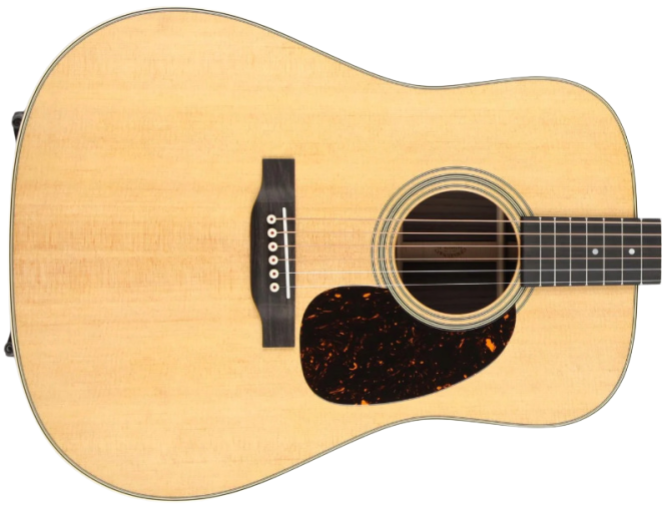
Cedar: Cedar soundboards are known for their warmth and responsiveness. Cedar-topped guitars are often favored for fingerstyle playing, as they produce a mellow and more complex tone.
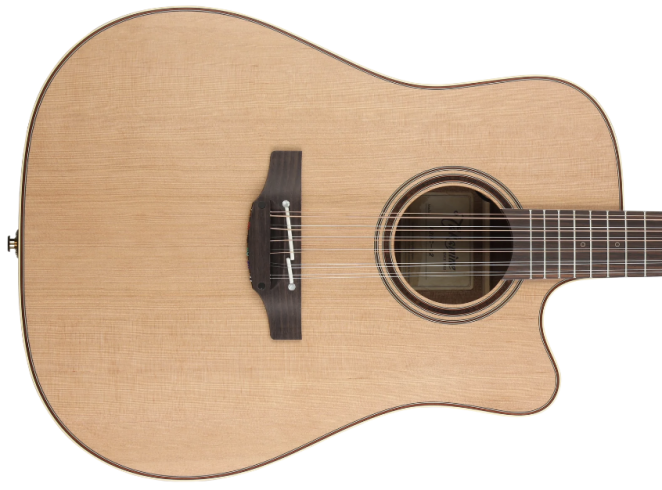
Rosewood: Rosewood is a popular choice for the back and sides of high-end guitars. Indian rosewood and Brazilian rosewood (highly sought after but now rare and protected) are known for their rich, warm sound and complex tonal characteristics. Rosewood can add depth and resonance to a guitar's sound.
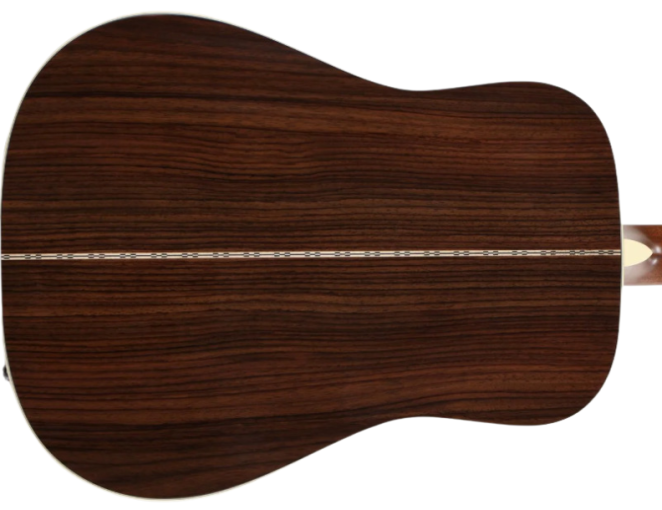
Mahogany: Mahogany is a classic tonewood choice for the back, sides, and neck. It offers a focused and more balanced tone with clear midrange frequencies.
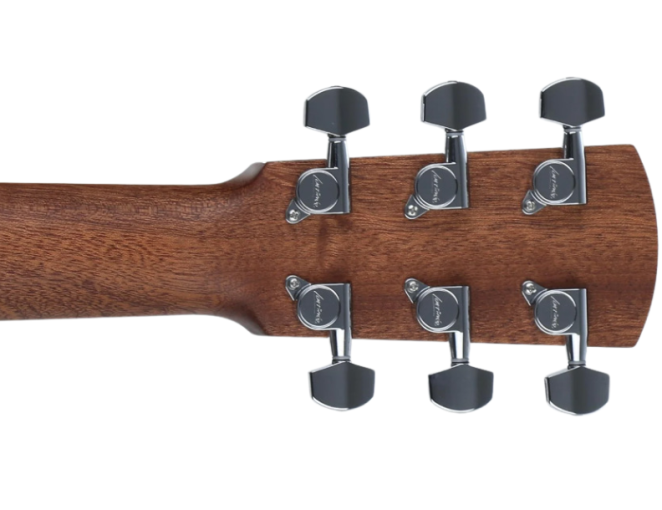
Maple: Maple is often used for the back and sides of acoustic guitars. It produces a bright and focused sound with excellent clarity. It's commonly seen on archtop and jumbo guitars.
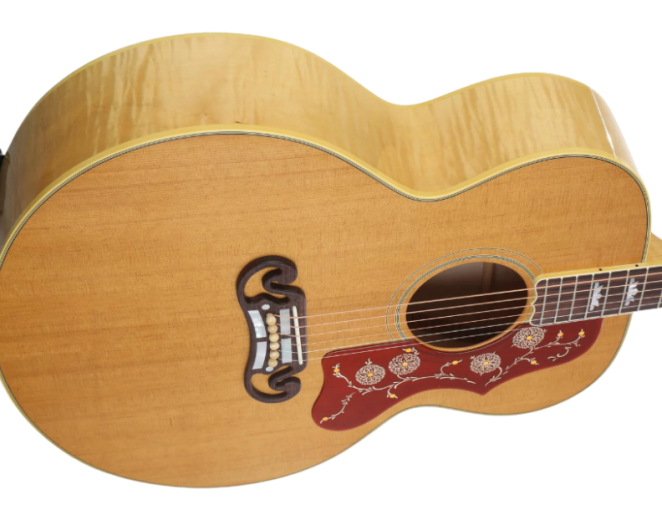
Ebony: Ebony is used for fingerboards and bridges. It's known for its durability, smooth texture, and enhancing the overall playability.
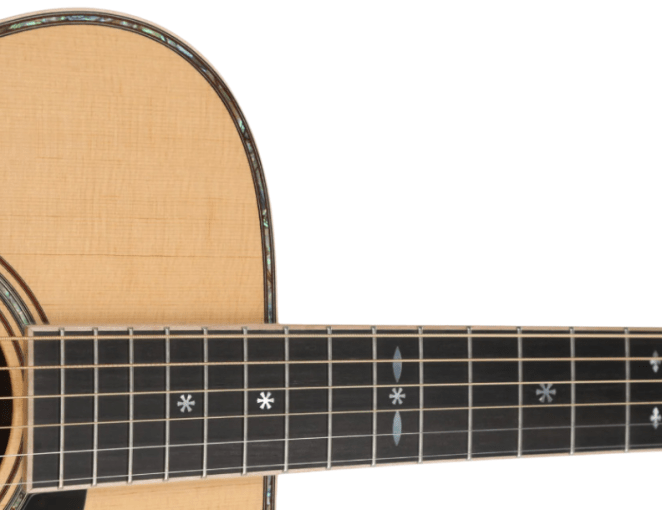
Body Style and Size
Super Jumbo and Jumbo
These are among the largest acoustic guitars, known for their deep bodies and rounded shoulders. They offer a powerful, boomy sound with a strong bass response.
I recommend Jumbos like the Gibson SJ-200 or the Guild F-55 for strumming and rhythm playing, especially in situations where volume is required like at the front of a band.
Dreadnought
Dreadnoughts are known for their large, boxy shape, square shoulders, and deep body. They offer a powerful and balanced sound with a strong bass response. Dreadnoughts like the Martin D-28 are versatile and are often favored for strumming and flatpicking styles.
I recommend this body style to pretty much anyone, as dreadnoughts are popular for both fingerstyle and rhythm playing.
Grand Auditorium
Grand Auditorium guitars are slightly smaller than dreadnoughts and have a narrower waist. They offer a balanced and versatile tone and project sound well and with excellent clarity.
Like dreadnoughts, Grand Auditorium guitars like the Taylor Guitars 814ce V-Class are well-suited for a wide range of playing styles, from fingerpicking to strumming. I recommend this body style for singer/songwriters and soloists –– it's not ideal for fronting a loud band, but can still hold its own.
Grand Concert
Grand Concert guitars are smaller and more comfortable to play, making them ideal for fingerstyle and intricate playing. They offer a focused and articulate tone, with a pronounced midrange.
I recommend this body style for singer/songwriters and soloists who might prefer a smaller body guitar for stage performance.
Concert
Concert guitars like the Yamaha LS36 ARE are slightly smaller than dreadnoughts and are known for their comfortable playability and balanced sound. They work well for fingerstyle and light strumming, making them perfect for all kinds of music genres.
Parlor
Parlor guitars are the smallest of the acoustic guitar body shapes. They have a vintage vibe and produce a balanced sound with less bass than larger guitars.
This body style can sound a little bit lighter and more trebly than the rest, making them great for cutting through a solo vocal without overpowering, especially in blues and folk music.
Neck and Scale Length
The neck profile, including its shape and thickness, is a huge factor in determining how comfortable your guitar-playing experience is. A lot of high-end guitars focus on comfort as well as sound, so you'll find many with comfortable neck profiles designed for ease of playing.
Most players typically prefer a modern thin neck profile, as you'll find on most of the guitars on this list. Thicker, chunkier necks are more commonly found on vintage guitars and are something of an acquired taste, along with heavier gauge strings and battle scars!
The scale length also affects playability, as well as string tension. Longer scales typically offer more projection and sustain, while shorter scales can be easier to play. I typically recommend choosing a scale length that suits your style and comfort.
Bracing
Lattice Bracing: Lattice bracing is a complex and labor-intensive pattern used in high-end classical guitars and some steel-string guitars. It features a lattice-like design with multiple intersecting braces. Lattice bracing allows for greater volume, projection, and sustain, making it popular among virtuoso classical guitarists.
X-Bracing: This is the most widely used bracing pattern in steel-string acoustic guitars. It consists of two diagonal braces that cross in an "X" shape beneath the soundboard. It offers a balance between strength and resonance, providing a full, rich tone with good sustain. This type of bracing is very versatile and works great for various playing styles.
Scalloped Bracing: This is a variation of X-bracing where the braces are carved or "scalloped" to reduce their mass towards the ends. This allows the soundboard to vibrate more freely, resulting in increased volume and enhanced responsiveness. Scalloped bracing is found in many high-end guitars.
Forward-Shifted Bracing: In forward-shifted bracing, the X-brace is moved closer to the soundhole, away from the bridge. This placement enhances the guitar's bass response and volume, producing a more pronounced low end. This is common in many vintage-style and modern high-end guitars.
Non-Scalloped Bracing: Sometimes referred to as straight bracing, it features braces that are not carved out. This design provides a stiffer top and results in a more focused, controlled sound. Non-scalloped bracing is often used in classical guitars and some steel-string models.
Fan Bracing: This is primarily found in classical guitars. The bracing pattern consists of several thin, fan-shaped braces radiating out from the soundhole. This design provides a clear and articulate sound with a distinct emphasis on the midrange frequencies. It's well-suited for classical and fingerstyle playing.
Double-Top Bracing: This is an innovative design primarily used in classical and flamenco guitars. It involves the use of two soundboard layers with a honeycomb-like structure in between. Double-top bracing results in exceptional volume, clarity, and responsiveness.
A-Frame Bracing: A-Frame bracing is used in archtop guitars. It consists of two parallel braces that create an "A" shape, providing support to the arched top. This bracing design helps produce a warm, resonant tone, well-suited for jazz and blues.
Frequently Asked Questions (FAQs)
What defines a high-end acoustic guitar?
High-end acoustic guitars are typically defined by their superior craftsmanship, premium materials, intricate detailing, and exceptional tonal qualities, resulting in a higher price point than standard or mid-range acoustic guitars.
Are high-end acoustic guitars suitable for beginners?
While high-end acoustic guitars offer superior quality, they may not be the best choice for beginners due to their higher cost and advanced features. Beginners might benefit more from starting with a mid-range guitar and upgrading to a high-end model as their skills and appreciation for quality instruments develop.
Do high-end acoustic guitars require special care?
Yes, high-end acoustic guitars often require specific maintenance to preserve their quality and performance. This includes regular cleaning, proper humidity control, and occasional professional setup and maintenance by a qualified luthier to ensure the instrument remains in optimal playing condition.
Are vintage high-end acoustic guitars better than modern ones?
Vintage high-end acoustic guitars can offer a unique and sought-after sound, but their condition and maintenance history are crucial factors. Modern high-end guitars often benefit from advancements in design, technology, and manufacturing processes, offering improved playability and consistency.
Can I customize a high-end acoustic guitar to my preferences?
Many high-end acoustic guitar manufacturers offer customization options, allowing you to select specific tonewoods, inlays, finishes, and other features to tailor the instrument to your preferences.
Final Thoughts
If you're in the market for a musical instrument that represents the finest of craftsmanship, you can't do much better than one of the high-end acoustic guitars on our list above.
These instruments combine meticulous attention to detail, premium tonewoods and hardware, and time-tested design for a playing experience that is second to none. Where other acoustic guitars can represent value, durability, and convenience, high-end acoustic guitars are made to shine above the rest, plain and simple.
My top pick for best overall had to go to the Martin D-28 for its absolutely iconic tone, unrivaled craftsmanship, and next-level comfort and durability––it's simply the gold standard for what an acoustic guitar should be, and pretty much always has been.
But whether you're a professional musician, a collector, or just a music enthusiast who is looking for the very best that the acoustic guitar market has to offer, we encourage you to take the plunge and pick one of these incredible instruments today!
